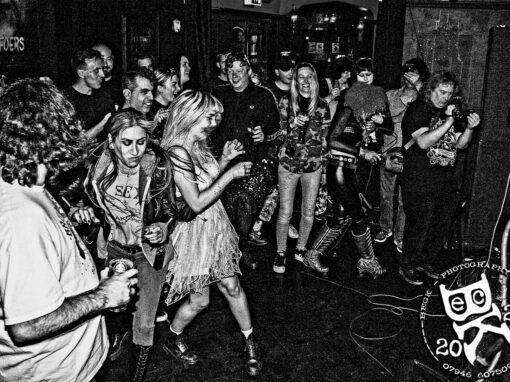Images from Lily Roulston with permission
Creators in larger bodies are showing us what’s on their plate, and people have been watching the TikTok food trend from a different perspective. From relatability to backlash, what happens when plus-size people take the camera?
It’s a normal workday in Liverpool for 27-year-old Chloe French. She hears the familiar click of the kettle, fills her pot noodle with boiling water, and sets her phone up on the desk ready to record. No editing, just an unfiltered account of the things she ate that day.
After all, no one was going to see it, she thought. She adds the voiceover and hits upload: “What I eat in a day as someone who’s just trying to live her best life.”
Chloe, known on TikTok as @chloesshitpost, joined Tiktok during the pandemic. Her video would be one of many uploaded that day as part of the ‘what I eat in a day’ trend, which allows users to document their daily food choices.
Within weeks, Chloe’s videos began gathering traction, thousands eager to see what lunch she would bring to work each day.
Today, Chloe’s follower count stands at over 100,000. She became part of a new viral movement among plus-size creators, unapologetically sharing their diets on the internet. It wasn’t for showing what society thought she should eat, but for showing what she does.
“For some people, they were really glad that it was just free eating. No rhyme or reason. No plans,” she says.
For years the food content space had been dominated by calorie-cutting fitness fanatics. The difference was Chloe’s content was authentic – a real person eating whatever she wanted.
‘What I Eat in a Day’ (WIEIAD) content has existed for many years, but now, creators in larger bodies have the spotlight.
Long before influencers like Chloe took part, similar food content existed on platforms such as YouTube and Instagram. However, this content was popularized by fitness vloggers, in a type of food diary which initially existed to help others lose weight. Instagram’s algorithm also reinforced diet culture through the promotion of ‘aesthetic’ food – think green smoothies and acai bowls.
Then came Tiktok, the short-form platform that made WIEIAD content viral. With its ‘snackable’ content, it made videos easy to digest, and just as easy to recreate. Whether for comfort or curiosity, people can’t stop watching, Forbes have even boldly described the app as ‘digital crack cocaine’. The trend became accessible to anyone, with any body shape or diet. Food content was no longer restricted to weight goals and body checks, sometimes it was just lunch.
A 2023 article published in Eating Behaviours divided WIEIAD content into two categories:
Lifestyle and Eating Only. While lifestyle content displays disordered or restrictive eating, eating only content focuses on indulgent and often excessive food choices.
For Lily Roulston, a food creator based in Melbourne, the latter category pushed her to start creating videos.
She says, “This ‘what I eat in a day’ content really broke the barrier for me as a foodie, as I enjoy food for more than just fuel. It showed me that it isn’t shameful to eat while existing in a bigger body.”
The trend seemed to resonate as it was representative of the public. It’s no secret that all body types exist, what’s stopping them from participating in a trend?
For some, it can be tiring to see a constant stream of food that should be eaten, and likewise, food that shouldn’t be. For someone in a marginalized body, it can feel both validating and revolutionary to see WIEIAD content challenge internalized beliefs.
However, plus-size creators’ newfound empowerment through food is not immune from criticism. Whereas thinner creators’ large lunches and takeaway nights are met with praise, creators in bigger bodies are often villainised for doing the same thing.
Popular UK creator Becki Jones even chose to leave the platform in favour of her mental health, the decision coming after comments focused on her weight rather than what was on her plate.
Stuart Flint, an associate professor at the University of Leeds, has studied weight stigma and discrimination for 20 years. He says: “The societal message is always that obesity is purely about a lack of willpower and the choices that people are making.”
“This idea that we can change our weight status in a rapid fashion in a few weeks or a few months, it’s just displaced.”
According to a survey done by the NHS in 2022, 64% of the adult UK population are considered medically overweight or obese. This data shows that the filtered snippets we see on our phone screens are sometimes disconnected from the bodies of real people.
Lily Roulston says: “The common narrative is that if you post something on the internet, you’re subjecting yourself to the criticism of others.”
“With more scrutiny comes more eyes to your profile.”
But behind her online eating persona, she struggles with Ankylosing Spondylitis, a chronic inflammatory condition that affects her mobility.
“I don’t believe that my struggles should mean that I have to deny myself the joy food can bring. I think there is more to life and my condition than losing weight.”
Lily’s seemingly innocent food content on her profile inadvertently exposes the fatphobia deeply ingrained in online culture. Creators have seen themselves reduced to how they look in a 15-second frame, often overshadowing their food content.
But maybe that’s also what makes this moment so significant. People don’t understand what they see when their definition of ‘influencer’ doesn’t conform to societal ideals. Millions of internet users enjoy seeing something different on their screens. But people in larger bodies have always eaten, its only in the last few years that people are seeing it. Whether people choose to attack or fixate, they’re still following, and curvy creators are breaking boundaries.
For every person that leaves a hate comment, is another inspired by their free-spirited way of eating. Lily was once one of these people.
“I can’t imagine if I hadn’t come across WIEIAD content, that I would be stripping myself from this quality time with those I love based on how many calories I had in that day.”
A platform that once rewarded low-calorie superfoods is now also giving a platform to pot noodles. Where the trend goes next is hard to predict. Social media moves fast. But the diversity of everyone’s bodies, diets and stories has so far given the trend its staying power. But something shifts when someone new chooses to click record. That shift hasn’t just made space for new voices; it’s reshaped what food content can look like.
Chloe still records her lunches. The kettle still clicks. She never thought anyone would watch, but 100,000 people do. This simple act is enough for creators in larger bodies to reclaim a timeless trend – one bite at a time.
For more stories on Social Media click here: https://illuminatedmag.co.uk/social-media/




